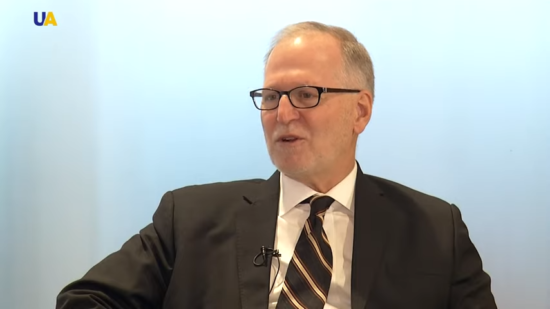Well, it’s good that the U.S. and China are talking, and it’s good that they are trying to find a resolution to their conflict. It’s creating a lot of uncertainty in the global economy, and that uncertainty is affecting firms, investment decisions, and may be affecting consumers’ purchasing decisions. So, we’re getting this negative effect of tariffs, what we economists call deadweight losses – those are small compared to the knock-on effects to business investment, and that’s where we get very concerned. So, trying to resolve the uncertainty around trade, and we do think the uncertainty when it comes to firms and consumers making decisions, is pretty important. So, a small agreement might be a step in that direction. It would be better, I think, if overall, a broader agreement was reached, then the commitment to the multilateral trading system, the WTO, would be even better. A challenge around the small agreement if China agrees to buy a certain amount of agricultural products from the United States, what does that do to Brazil or Argentina? The whole idea of the WTO is that there’s this level playing field, where countries and their firms are competing equally to access the other markets. They face the same tariffs, they face the same kind of sanitary, phytosanitary and technical barriers. But once countries start negotiating these very bilateral, very focused, what may be (I don’t know, I haven’t seen it) managed trade, then you start to break up that level playing field.
How does technology and modern-day economic challenges affect the unity within the WTO, because, obviously, some countries have a much bigger advantage in certain areas, and other countries have disadvantages?
Well, that’s a natural part of trade. There was this famous academic and person from England, David Ricardo, who talked about comparative advantage, so it’s natural that countries have different areas of relative capabilities and expertise, but it is causing relatively rapid change, it’s very disruptive. Many people complain about openness and trade being disruptive, but our research suggests that other factors, like technological change, moving to this digitalized economy and changing consumer preferences have a much bigger effect then trade openness. But the effects of trade openness can be concentrated in industries that have been around for a while, while new industries, the new technology-based industries are rising, and they haven’t been around that long. In the WTO we don’t have a set of agreements that clearly touch upon this. Some would argue that our agreement on services touches much of this, but members need to sit down and really think hard about whether we need explicit rules in this area. And there’s an effort right now, called the joint initiative on e-commerce, where a large number of members are trying to see if they can reach agreement on some of these digital economy issues.
And they are growing so fast and changing so fast as well.
They’re changing fast, and you know, one then needs to make sure you design a flexible agreement that incorporates learning and experience, and adapts over time.
And a lot of this is down to labor, and in Ukraine, the population is declining, a lot of people migrate to nearby Poland to work, because of the better wages. So, what sort of policy, do you think, the government should have to ensure that the labor stays here, and is that really up to the government entirely to ensure, or is that up to the business in general?
I think there needs to be a cooperative effort. You know, I mentioned a few minutes ago that we’ve found in our research that the negative effects from trade opening tend to be relatively small compared to the negative effects resulting from technological change and change in consumer preferences. What it all points to is the need for a well-designed and coherent domestic and international policy. You can’t set one policy without thinking about what the implications are for the other. And when it comes to domestic policy, you need to think about labor market policies, you need to think about education policies, safety net policies, and try to design them as something you can afford, but also that they are enduring and they reduce as much of the uncertainty that workers and general citizenry might face in these rapidly changing times.
How would you access the future of trading blocs? Because we have the European Union, which is the biggest market, and then to the east of Ukraine we have the Russia-led market as well. But, since borders are becoming more and more open, what’s the future of these trading blocs?
Well, many of the trading blocs are based on agreements that go deeper than the WTO agreements, particularly in the regulatory and non-tariff measure areas, and what those do is, first of all, often they are not discriminatory, so when you join a regional trade agreement that has regulatory requirements, it’s hard to, then, have these regulatory requirements in a discriminatory way, so even non-members of the agreement can meet those regulatory requirements. So, often those things are very valuable in that they help clarify what the rules of the game are for trading. So, we at the WTO tend to think that things like regional trade agreements, well-designed customs unions can be very helpful, but at some point members need to come together and see if they can start patching them together, or, ideally, learn from them and come to the WTO, and create some of those deeper rules at a multilateral global level.
Yes. I mean, because, for example, Ukraine is part of the WTO but is not a part of the European Union, so the exports that go to the European Union must meet certain standards, but products that are sold here don’t necessarily need to meet those standards if it’s done domestically. So that’s a disadvantage, I guess?
Well, it can be a disadvantage, it depends on what your market is, right? So, if you’re a domestic producer, and you’re just producing for the domestic Ukrainian market, then you don’t have to meet the different standards that the EU may hold. But if you want to serve both markets, typically, what you’ll do is you’ll try to create a production process that hits the higher standard, and then you deliver that into both markets.
In Ukraine a lot of the banks are part of the state, I think it’s about 50 to 55%. Often there’s an argument in classic economics, from what I remember from university, is that lower barriers to trade means increasing welfare. That’s, of course, if you don’t have market collapse or anything like this. So, how does the state balance between what it controls and what it shouldn’t control in a country like Ukraine, where there are ambitious targets for economic growth, there there are sectors, which are both traditional sectors, like exports of steel and coal, and also a technological sector as well? So, how do you balance that?
Referring to this challenge, in one of your earlier questions. It’s not just a government’s role, not just a private sector’s role. It takes both of them. And it takes clear and pretty stable, and flexible regulatory environment that aims to meet the needs of the domestic population. Meets the needs of foreign regulatory requirements. But allows firms to innovate. If you don’t allow firms to innovate, if you may recall — something called the production possibility frontier. Which essentially is a representation of productive capability of all the resources available domestically. The biggest part of growth, when you are a rich country is through productivity gains, technological change. You’ve mentioned Ukraine has a declining population — many rich, developed countries have a declining population. This means, that growth through increases in labor, or in population are gonna be very hard. That means you are relying on investment, but also on the efficiency and productivity of that investment. And if you don’t have the innovative sectors. If you don’t allow the private sector to try to find good ways to use that scarcer capital and improve the quality of the workforce — growth is gonna be slow. The policy should be relatively open, clear and transparent. The state has an appropriate role in making sure it is protecting the citizens’ basic rights. This is the role for the state. But when the state has a too heavier hand, then you don’t get the adaptation, you don’t get innovation, you don’t get change. And then growth slows. This is pretty clear from most of the economic research.













